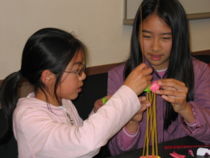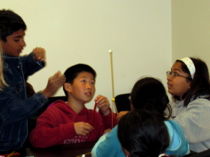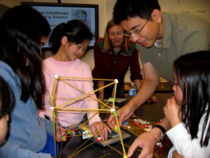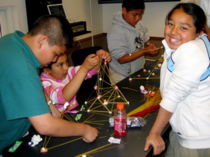| Line 1: | Line 1: | ||
| − | ==conferences & | + | ==conferences & travels== |
06/20/07-06/24/07 [http://divisions.asme.org/bed/events/summer07.html asme summer bioengineering conference], | 06/20/07-06/24/07 [http://divisions.asme.org/bed/events/summer07.html asme summer bioengineering conference], | ||
Revision as of 12:44, 29 September 2007
Contents |
conferences & travels
06/20/07-06/24/07 asme summer bioengineering conference,
keystone, colorado
07/02/07-07/05/07 instabilities across the scales,
delft, the netherlands
07/16/07-07/20/07 iciam 07,
zurich, switzerland
07/23/07-07/26/07 9th usnccm,
san francisco, california
08/20/07-08/23/07 the a-team 2008,
caltech, pasadena, california
09/20/07-09/21/07 growth in the desert,
workshop, tucson, arizona
01/23/08-01/25/08 multiscale / multiphysics,
workshop, university of sheffield, uk
02/27/08-03/01/08 computer methods in biomechanics
8th international symposium, porto, portugal
03/02/08-03/05/08 orthopaedic research society,
54th annual meeting, san francisco, california
06/18/08-06/21/08 cellular, molecular & tissue mechanics,
iutam symposium, woods hole, massachusetts
06/25/08-06/29/08 asme summer bioengineering conference,
marco island, florida
08/24/08-08/30/08 ictam 2008,
adelaide, australia
08/31/08-09/06/08 mathematics of growth & remodeling,
miniworkshop, oberwolfach, germany
09/09/08-09/13/08 from structural optimization to biological evolution,
summerschool, france
10/20/08-10/24/08 progress in the configurational mechanics,
iutam symposium, erlangen, germany
spaghetti towers @stanford
you guys are all great engineers and we had loads of fun building towers with you!
here are some impressions of the stanford class of engineering 2020 and their spaghetti structures!
more photos: spaghetti towers 01, spaghetti towers 02
| justine & lindy - the highest but heaviest |
|---|
|
with a height of 3.8 spaghetti lengths, justine and lindy built one of the highest towers! it's foundation is totally laffy taffy and beautiful! due to its colorful but massive candy basement, the building was not only the highest but with 112g also the heaviest construction of the day. congrats to justine and lindy for this beautiful high tower! |
| edward, hanson, abhishek & sean - the real engineering one |
|---|
|
our favorite engineers of the day! edward, hanson, abhishek & sean really worked together as a team and created this cool 1.4 story building. due to its truss structure (and because you guys ate the laffy taffys rather then build them in) this 47g structure is super light! guys, you should definitely become engineers! |
| karishma, abi, aaron & brijen - the highest |
|---|
|
the most slender and elegant structure was designed by karishma, abi, aaron & brijen. with only 44g it was superlight and yet 3.6 spaghetti lengths high. it needed a little human support but its triangular foundation was totally solid and stable! congratulations to this team for its really great engineering design! |
| megan, vina, anna, claire - the nonsymmetric one |
|---|
|
who said that girls can't build towers??? this girls only team added an extra challenge by making their truss structure nonsymmetric. it was 1.4 spaghettis lengths high and one of the most beautiful buildings of the day! weighing was a challenge though due to its width! congrats to this great team! |
| the most stable one |
|---|
|
this one's really great! super engineered and 2.4 spaghetti lengths high and yet extremely light! definitely one of our favorite architectural designs! congratulations to this super cool tensegrity structure! buckminster fuller would love it! |
more photos: spaghetti towers 01, spaghetti towers 02
the mathematics of growth & remodeling of soft biological tissues
miniworkshop
mathematisches forschungsinstitut oberwolfach
08/31/08-09/06/08, oberwolfach, germany
ellen kuhl,
davide ambrosi,
krishna garikipati
abstract biology is becoming the most attractive field of application of mathematics. the discoveries that have characterized the biological sciences in the last decades have become the most fertile matter for application of classical mathematical methods, while they offer a natural environment where new theoretical questions arise. mathematical biology' has born many years ago and has developped along directions that now constitute its traditional background: population dynamics and reaction-diffusion equations. nowadays mathematical biology is differentiating into several branches, essentially depending on the specific spatial scale size under consideration: molecular scale (i.e. dna transcription, protein folding and cascades), cellular scale (i.e. motility, aggregation and moprhogenesis) and macroscale (i.e. tissue mechanics). currently one of the most attractive scientific topics is the mathematics of growth and remodelling of soft biological tissues. this area, located at the crossroads of biology, mathematics and continuum mechanics, concerns the statement and analysis of the equations that characterize the mechanics, growth and remodelling of systems like arteries, tumors and ligaments, studied at the macroscopic scale. these are open continuous systems that pose new challenging questions, which go beyond the standard mechanics that is traditionally devoted to closed systems. past initiatives in oberwolfach have been devoted to the interaction between biology and mathematics in a broad sense. a minisymposium in oberwolfach focusing on the mathematics of growth and remodelling of soft biological tissues' would be the occasion to bring together established researchers on this topic with newer entrants to the field.
multiscale modeling of materials
minisymposium
9th usnccm
07/23/07-07/26/07, san francisco, usa
ellen kuhl,
ekkehard ramm
abstract multiscale modeling of materials has advanced to a research topic of growing interested in the past decades. This trend is driven by the desire to characterize the material behavior, in particular in the context of material failure, as accurately as possible by looking at the characteristic substructure of the material on smaller scales. a typical example are granular media which can be described through phenomenological continuum theories on the macroscopic level while discrete particle interaction theories provide further insight in their complex failure phenomena on the microscopic level. bridging the gap between the different scales is one of the most challenging problems in multiscale modeling. from a computational point of view, this task can be accomplished in two different ways: the individual scales can either be coupled horizontally or vertically. In the former approach, which could be thought of as a kind of model adaptivity, the material characterization is refined in regions of particular interest, e.g. in potential failure zones, while the remaining part of the structure is still modeled on the phenomenological level. the vertical coupling approach is maybe more common in material modeling. while continuum-based strategies like the finite element method can be applied to simulate the material behavior on the macroscopic scale, discrete element techniques, particle methods or dislocation dynamics are typically applied to characterize the material response on the microscopic scale. the vertical coupling thus essentially aims at defining appropriate analytical or numerical homogenization techniques to carry discrete microscopic information up to the macroscopic phenomenological level. within this mini-symposium, we encourage abstracts related to the following key issues: micromechanically motivated constitutive models, higher order continuum theories, discrete element simulations of different failure phenomena, enhanced finite element techniques to simulate overall structural failure, multifield aspects of material failure, model adaptivity, computational homogenization techniques, and experimental validation and parameter identification.
computational methods in biological growth and remodeling
minisymposium
9th usnccm
07/23/07-07/26/07, san francisco, usa
ellen kuhl,
krishna garikipati
abstract this symposium will focus on theoretical and computational methods for mass and volumetric change (growth) and microstructural changes (remodeling) in biomechanical problems. over the past two decades, a number of theoretical approaches have been laid down to explain functional adaptation of biological tissues. Included among them are the classical theory of adaptive elasticity, open system thermodynamics, reaction diffusion in porous media, mixture theories and different theories of microstructural evolution. within this minisymposium, we would like to turn the focus somewhat to the challenges related to the computational realization of these theories, while still recognizing the need for continued theoretical development. with these aims in mind, we invite abstracts addressing (but not necessarily restricted to) the following topics of relevance to biological growth and remodeling: further development of growth and remodeling theories, algorithms for multifield phenomena of mechanics, transport and reaction, appropriate formulation and time discretization of biological rate equations, computational treatment of scale interaction in space and time,
the role of computational homogenization techniques, and relaxation methods in microstructural evolution.



